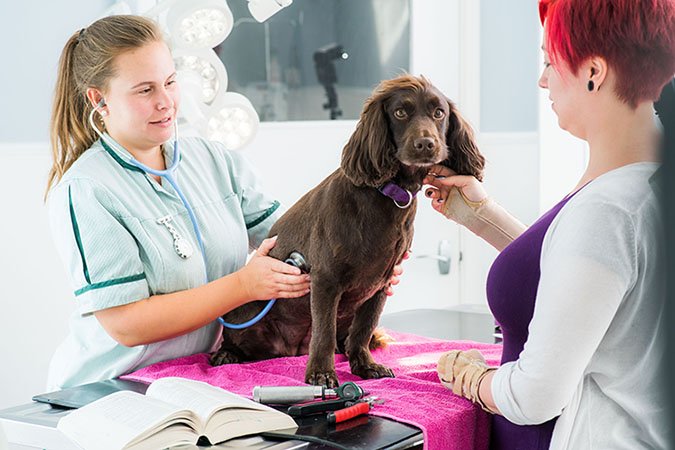Vet's 20 simple hacks to save dog owners money
Owning a dog is a privilege, but also a big responsibility. Estimates suggest it can cost as much as £30,000 to keep, feed and care for a dog over their lifetime.
There are concerns the cost-of-living crisis will add to that figure, forcing some owners to rehome their dogs.
Our vet, Dave Tweedle, has put together these top tips to help you keep costs down and avoid that nightmare scenario.
1. Keep up to date with parasite prevention
Parasites such as fleas, ticks, lungworm and roundworm (and hookworm, whipworm and tapeworm) can cause serious health issues in dogs. Treatment for lungworm alone can cost as much as £2000. It’s much cheaper in the long run to prevent these from becoming an issue.
2. Make sure your dog is vaccinated against serious diseases
If vets were in it for the money, as they’re often accused, they wouldn’t vaccinate dogs or puppies against serious diseases such as parvovirus, leptospirosis, distemper, infectious canine hepatitis and kennel cough, as treating these is far more expensive than giving dogs vaccines to prevent them happening in the first place.

3. Measure out food carefully
One in 14 dogs in the UK is obese, which means they’re more likely to suffer from expensive-to-treat conditions such as arthritis, breathing problems, heart disease, diabetes and certain types of cancer. It’s really important to measure your dog’s food, rather than guess. This is likely to save you money on food in the short term and vet bills in the long term. It may also help your dog live longer.
4. Give treats sparingly
Scoffing too many treats is another common reason dogs put on weight. Complete pet foods have everything a dog needs to stay healthy so only give treats in moderation, if at all.
5. Exercise your dog regularly
In humans, physical activity has been proven to aid weight loss, lessen heart disease and control depression among other things. It’s the same for dogs. There are few better preventative measures against illness than regular exercise.

6. Brush your dog's teeth every day
It’s reckoned around two-thirds of dogs over the age of three suffer from periodontal disease, which is an infection of the tissues surrounding the teeth — and expensive to treat. It starts with plaque forming and this thickens to become tartar. The best way to prevent tartar build-up is through daily brushing with a special toothpaste.

7. Get a six-monthly health check
It’s worth putting your dog through an MOT twice a year. This gives your vet the chance to check for subtle cues that something may not be quite right. If this check-up reveals an underlying health problem or perhaps a more straightforward issue like an ear infection or skin condition, you will save money in the long term by treating it early.
8. Join a pet health plan
Preventative healthcare plans are offered by most vets and generally provide outstanding value for money. You pay a monthly fee, and this covers vaccinations, regular parasite treatment and microchipping. Some, such as the Pet Health Club, also provide six-monthly nose-to-tail health checks as well as significant discounts on neutering, dentistry, specialist food, animal health certificates and lifelong medication. Beware of online retailers offering preventative healthcare plans at discounted rates — the treatments are rarely vet-prescribed, and they don’t offer the same perks.
9. Learn how to home groom
Ideally, you should brush your dog’s fur every few days if they’re short-coated and daily if they’re long-haired. This will not only keep their coat and skin in good shape, but it will also prevent matting, help them stay cool and allow you to keep an eye out for fleas or parasites. This is another good preventative measure as it will potentially save you money on veterinary treatment in the long term, not to mention reduce the need for professional grooming.
10. Shop around for pet insurance
Unplanned veterinary treatment can be expensive and good insurance will cover everything from out-of-hours emergencies to cancer therapy. Just do your research first, and always compare policies.
11. Learn how to clip nails at home
If your dog’s nails become too long it can put pressure on their pads and paws, which causes strain in the legs and knees. Learn how to cut your dog’s nails safely here.
12. Make your own toys
Commercial toys are expensive and don’t always last long. There are loads of ways to stimulate your dog using things like cardboard containers, tea towels and old plastic bottles.

13. Avoid unnecessary clothes
Dogs have natural coats. They don’t need designer gear or decorative adornments. The only clothes you should ever spend money on are those needed to provide them with warmth during bad weather or to make them more visible in the dark.
14. Keep dangers well out of paws’ reach
One of the most common reasons dogs need expensive emergency treatment is swallowing something toxic. Chocolate, raisins, plants, household products and human medications are among the main culprits. In many cases, dogs get a hold of these things because their owners have failed to keep them out of reach. Don’t make the same mistake.
15. Check if you qualify for low-cost treatment
Some pet owners, particularly those on certain benefits, may qualify for free or subsidised treatment from charities such as PDSA, Blue Cross and the RSPCA. Just visit their eligibility checkers online. If you’re worried about paying for veterinary care, speak to your vet about tailored treatments and payment plans. Just remember burying your head in the sand could lead to bigger problems further down the line.
16. Learn minor healthcare
You don’t always need to rush to the vet if your dog’s not 100%. It’s often fairly simple to treat minor issues such as bee and wasp stings and mild diarrhoea, or to clip nails and remove ticks. If you’re worried about your pet’s health and not sure if you need to see a vet in person, try an online consultation first. At Video Vets Now, this costs £30 but you’re refunded the fee if you need to visit your vet.
17. Get your dog neutered
Although most dogs will give birth without needing veterinary help, that’s not always the case. Caesarean sections are sometimes needed, especially in flat-faced dogs, and can be expensive. As well as removing some risks associated with pregnancy, fatal infections and some cancers, neutering also improves the overall health of your dog.

18. Make sure your dog is microchipped
Microchipping is a legal requirement in the UK. It usually costs £15 to £20 but is free for Pet Health Club members. Owners can face fines of up to £500 for not microchipping their dog.
19. Poo bags on the cheap
Poo bags are another regular cost for pet owners. But they don’t have to be. Some councils give them away free at libraries and other facilities. It’s also worth shopping around as their price varies — and don’t forget to check the price of nappy bags as they do just as good a job.
20. Use a pet food bank
It’s a sad fact that pet food banks are a thing, but that’s the reality. If you’re really struggling to make ends meet and need help to feed your dog, a food bank may be a last resort. There are dozens up and down the country.



